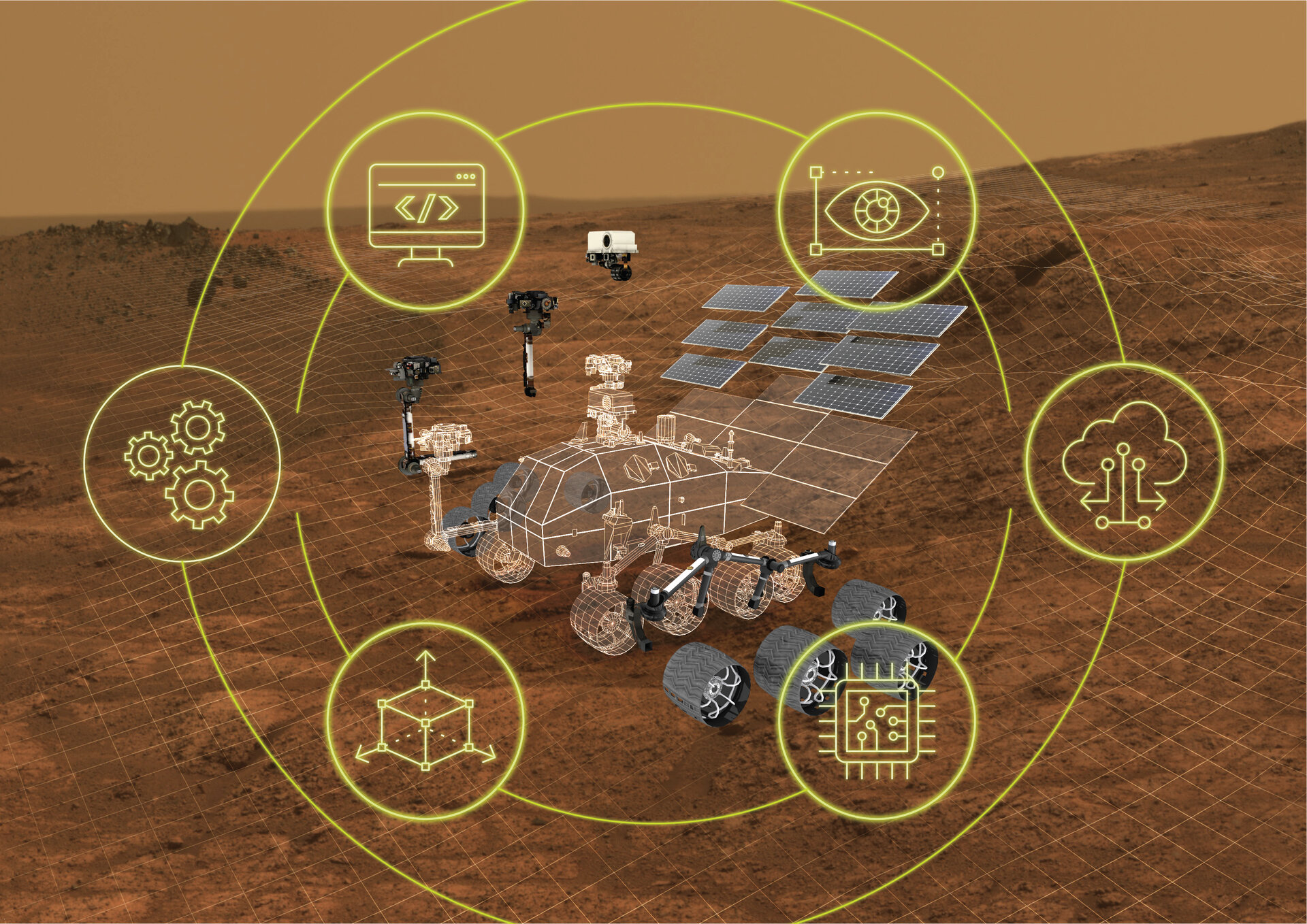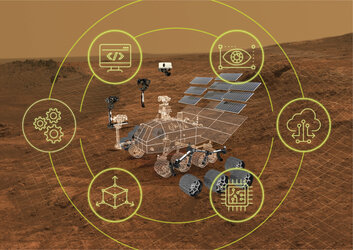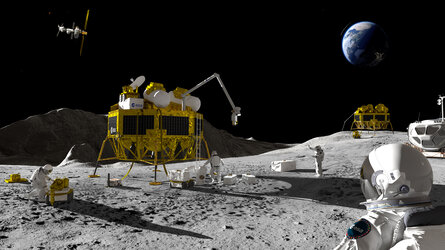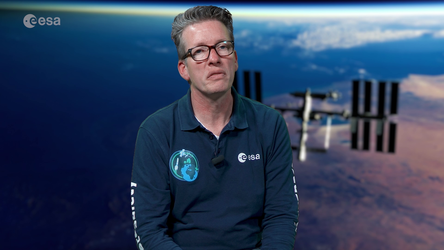Goodbye Documents, Hello Models: A Model-based Approach to System Engineering
The space industry is entering a new era of digital engineering and information management. New methods need to be found to manage information and projects as they move between different engineering disciplines. Often, these disciplines are linked by data models, to ensure that engineering data stays consistent across different projects and activities. This model-centric approach is known as Model Based System Engineering (MBSE).
MBSE provides a powerful digital framework for representing complex systems. Improvements in both time and cost can be achieved by placing digital models at the centre of the engineering process, providing a common understanding of the system engineering design, and thus reducing inefficiencies and mistakes due to inconsistent information in disjointed documentation.
Revolutionising the traditional, document driven approach to system engineering is key to ESA’s Technology Strategy and Agenda 2025. ESA seeks a 30 % improvement in the spacecraft development time and improved cost efficiency by an order of magnitude with every generation. Reaching these ambitious targets requires more than just technology improvement, but also a change in the spacecraft development process and engineering mind-set. This can be achieved with MBSE.
ESA projects are characterised by heavy engineering efforts from geographically dispersed teams in ESA and industry. Digital continuity throughout the life cycle of projects allows the substantial reduction of cost and efforts and will shorten schedules. ESA will therefore digitalise its full project management, enabling the development of digital twins, both for engineering by using Model Based System Engineering and for procurement and finance, achieving full continuity with industry. - ESA Director General, Josef Aschbacher (Agenda 2025)
Information that is traditionally captured and exchanged in the form of documents and Excel tables is instead expressed as a set of data-driven, rigorously structured models. A model-centric approach to data and information management provides an unambiguous authoritative source of truth, based on a common language and digital approach. Data models are used to create a digital representation of the different mission elements, subsystems and equipment of the space system, including their interdisciplinary relationships. This is used to manage the growing complexity of the system design and development, while maintaining the traceability, consistency, and optimisation of the mission architecture – retaining system knowledge, by capturing decisions and design trends.
Several ESA missions have now embraced MBSE, adopting a digital engineering approach throughout the mission specific system life cycle, technical disciplines, and supply chain. Selected examples are given to highlight how ESA missions are using MBSE at mission or system level, and throughout the different implementation phases (covering phase 0 – phase C/D).
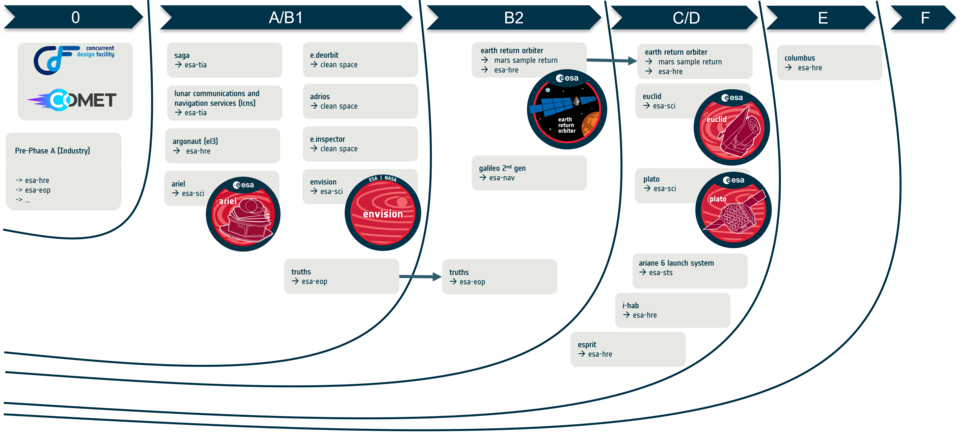
Specific user needs being addressed are:
- Managing the increasing complexity of space missions.
- Supporting compliance with best practice and ECSS standards; ensuring consistency, completeness, and feasibility of the mission requirements and (sub)system design.
- Ensuring stakeholders and non-MBSE proficient users understanding and communication on the mission & system design.
As soon as an update is made and approved within the MBSE model, the change is propagated throughout the technical disciplines and becomes accessible to everyone immediately.

The ESA Concurrent Design Facility (CDF) uses MBSE to support its feasibility assessment of new missions, payloads or space system concepts (early phase 0). For building shared engineering budgets, the COMET tool is used. COMET provides a centralised, collaborative data model that enables engineers to work with near real-time synchronisation between all stakeholders.
Phase A/B1 studies are the study phases dedicated to defining the early feasibility of an ESA mission. There is a variety of MBSE solutions used by the missions teams, both at ESA and in industry. A substantial effort is being dedicated to develop a model-based engineering hub, enabling the smooth communication and data exchange within this heterogeneous ecosystem.
The ESA Clean Space Office was the first to investigate the use of MBSE in many of its activities. An early pioneer was the e.Inspector mission - to inspect an uncontrolled satellite and assess the viability of a subsequent deorbit mission - which complemented the initial CDF study outputs with a MBSE requirement and functional model. The model was then provided as an input to the phase A study with the industrial team. The e.Deorbit mission used MBSE more extensively with a highly integrated and collaborative MBSE approach to system modelling. e.Deorbit aimed at removing a large piece of ESA-own space debris from orbit, providing an early demonstration of the required clean space technologies. Although the mission concept has now been reborn as a space servicing vehicle known as ClearSpace-1, e.Deorbit was a huge MBSE success, demonstrating the broad benefits of using MBSE for designing future missions. MBSE was used to support the generation of the system requirements and the iterative development of the phase B1 mission architecture and system budgets.
TRUTHS, from the ESA Earth Observation Directorate, has been the first Earth Observation mission to implement MBSE from the definition phase.
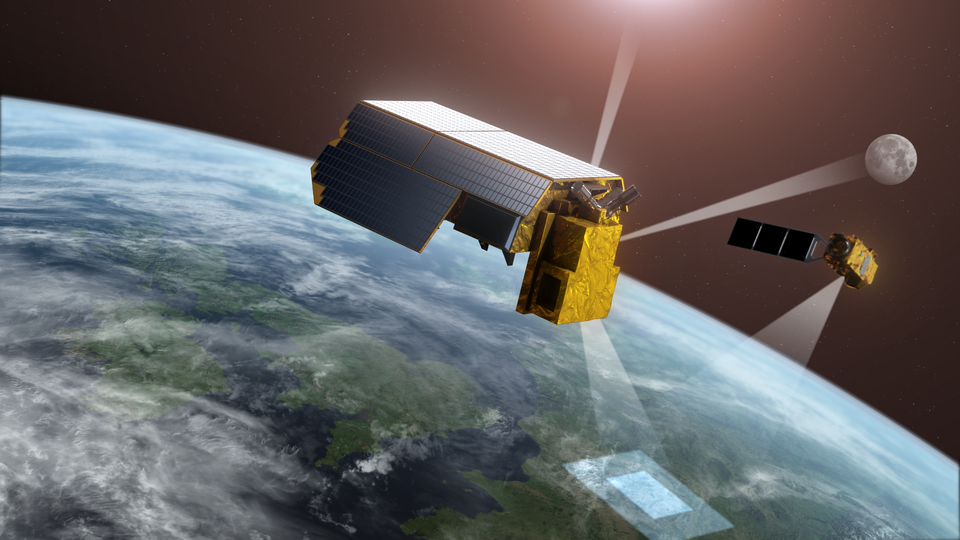
The satellite will measure incoming radiation from the Sun and radiation reflected from the Earth, improving the confidence in climate change forecasts, as well as establishing a ‘metrology laboratory in space’, creating a fiducial reference data set to cross-calibrate other sensors and improve the quality of their data.
A special MBSE focus addresses model-based requirement engineering, leading to the development of a digital integrated system model for the mission operations, as well as functional and physical architecture models of the space segment, including its interfaces to the ground segment. The digital model is set to become the single consistent reference point for the project team, effectively supporting the exchange of information between all the different stakeholders. A single engineering data model prevents the occurrence of unwanted inconsistences, serving as a common input to discipline specific analysis, and facilitating the ongoing baseline management and configuration control.
After an initial internal exercise, conducted in the early phase B1 by the ESA project team (ESTEC, ESOC, ESRIN) and focused exclusively on requirements and operations modelling, TRUTHS moved forward with MBSE with its satellite prime contractor Airbus Defence & Space Ltd (Stevenage, UK) during the Phase B1 bridging phase, supported by Airbus’ transnational organisation for digital transformation. In addition to serving as an authoritative source of truth for the various stakeholders, it is foreseen that MBSE will enable and facilitate specific system-level analyses, from requirements coverage and change impact analysis, to systematic model-based Failure Mode and Effects Analysis (FMEA), based on the digital system functional architecture. - Eric Joffre, Systems Engineer
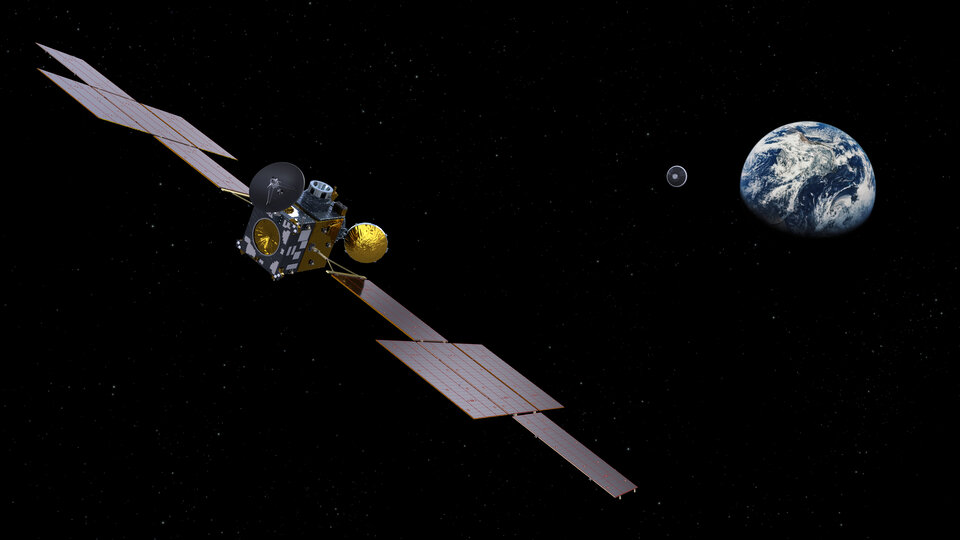
Missions in the later implementation B2 & C/D phases tend to adopt a single - or smaller sets of - MBSE approaches. ESA’s Earth Return Orbiter (ERO) mission, in the Human and Robotic Exploration Directorate, is one element in the combined ESA/NASA Mars Sample Return (MSR) campaign. MSR is a multiple-mission campaign to retrieve samples from Mars and bring them back to Earth. ERO will capture, contain, and seal the Mars samples in orbit, previously collected from the NASA Perseverance Rover, and deliver them safety back to Earth.
A robust system engineering approach is needed to cope with the programmatic and technical challenges of developing a cross-agency campaign, with effective communication between multiple and complex mission elements, the many different stakeholders and industry partners. MBSE methodology is used to control the mission complexity and manage the data exchange within a large engineering team, where the baseline design may undergo several design loops and iterations at different levels. Together with the industry prime, ESA has developed the MBSE Digital Integrated System model to capture all the system-level design information. A centralised database replaces traditional document-based deliverables. This is used to maintain technical consistency, control and traceability of not just the system mass budgets, but also the mission requirements, operational analysis, and the functional and logical architecture. Maintaining technical budgets is an integral part of the mission design process, and accurate data detailing the spacecraft design is needed to perform specific subsystem analysis.
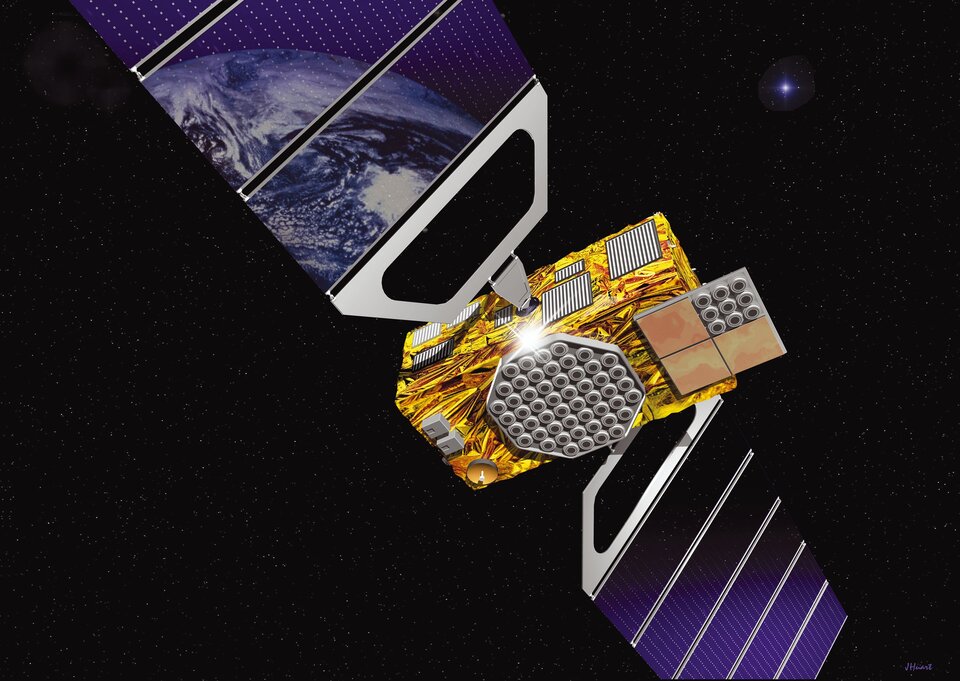
The European global satellite navigation system Galileo, from the Navigation Directorate, is currently the world’s most precise, state-of-the-art civilian satellite navigation system. Twenty-eight satellites are currently in orbit providing meter-scale accuracy to more than four billion users around the globe. Galileo’s Second Generation will provide improved accuracy with precision pointing to all at the decimetre-scale. Galileo is a very complex system. The large satellite constellation in Medium Earth Orbit is supported with a globally distributed ground segment with sites located across the world, plus many dedicated Galileo service facilities, external providers, and stakeholders. There is also a significant security contribution with different levels of classified information and need-to-know data.
The specific MBSE approach is led by the system team, to control the complexity of the design throughout the development and deployment cycle, from specification to development, qualification and operations. A MBSE centric methodology is a must to ensure consistency and completeness of the requirements from mission specification to system and sub-system deployed infrastructure.

PLATO, from the ESA Science Directorate will find and study extrasolar planetary systems, known as exoplanets, within the habitable zone around Earth-like stars. The MBSE approach adopted for this mission builds on earlier experiences from Euclid and has been combined with a dedicated PLATO Mission Parameter Database (MPDB), acting as a single reference repository for the PLATO mission system. MPDB provides an officially controlled and centralised representation of the payload and spacecraft models, containing all the information on the payload, spacecraft, launcher and ground segment elements. The MPDB is used regularly, integrating the different needs of the stakeholders from the ESA project team, scientists, ground station operators and industry into a single system model and (requirement) management tool.
The use of MBSE also extends beyond conventional systems engineering design applications. The centralised model approach can be used to improve the efficiency of routine mission operations and mission planning, providing improved performance at ESA’s European Space Operations Centre (ESOC) and enhancing use of machine learning. By effectively capturing and configuring the existing spacecraft modelling and mission information, the quality and efficiency of manual day-to-day planning and procedural activities can be improved. MBSE methods enable the configuration and verification of mission planning system models, and the generation and verification of operational procedures. The Ground-segment Engineering Framework (GSEF) paves the way for the future!
These success stories highlight the increased adoption of MBSE and the acknowledgement of its ability to provide a common system engineering approach. Currently, each mission tailors their own MBSE solutions based on the specific mission needs, heritage, use cases, resources, and stakeholders.
MBSE continues to be used throughout the different directorates at ESA and within the wider European space industry. There is a constant effort in finding new, optimal methods of integrating MBSE solutions into different space missions and between various stakeholders.
Lessons learned and roadmaps are continuously updated and discussed in liaison with the Model Based for System Engineering (MB4SE) advisory group - a multidisciplinary team of experts from ESA, national space agencies and industry. MB4SE advocate on the use of MBSE by providing a coordinated effort and definition of a common vision on how to successfully apply different MBSE solutions within the space sector. MB4SE is also actively engaged in building the MBSE community at large, by organising a yearly conference (2020, 2021, 2022) dedicated to MBSE achievements, challenges, and lessons learned. This offers a low-threshold forum to exchange experiences and define the path towards future evolution of MBSE and Digitalisation.
Per aspera, ad astra!















 Germany
Germany
 Austria
Austria
 Belgium
Belgium
 Denmark
Denmark
 Spain
Spain
 Estonia
Estonia
 Finland
Finland
 France
France
 Greece
Greece
 Hungary
Hungary
 Ireland
Ireland
 Italy
Italy
 Luxembourg
Luxembourg
 Norway
Norway
 The Netherlands
The Netherlands
 Poland
Poland
 Portugal
Portugal
 Czechia
Czechia
 Romania
Romania
 United Kingdom
United Kingdom
 Slovenia
Slovenia
 Sweden
Sweden
 Switzerland
Switzerland

























